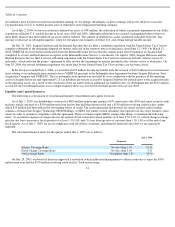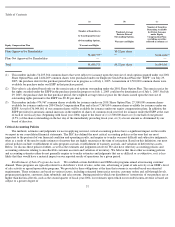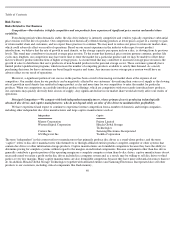Seagate 2004 Annual Report Download - page 45
Download and view the complete annual report
Please find page 45 of the 2004 Seagate annual report below. You can navigate through the pages in the report by either clicking on the pages listed below, or by using the keyword search tool below to find specific information within the annual report.
Table of Contents
The success of our new product introductions is dependent on a number of factors, including market acceptance, our ability to manage the
risks associated with product transitions, the effective management of inventory levels in line with anticipated product demand, and the risk
that our new products will have quality problems or other defects in the early stages of introduction that were not anticipated in the design of
those products. Accordingly, we cannot accurately determine the ultimate effect that our new products will have on our results of operations.
In addition, the success of our new product introductions is dependent upon our ability to qualify as a primary source of supply with our
OEM customers. In order for our products to be considered by our customers for qualification, we must be among the leaders in time-to-
market
with those new products. Once a product is accepted for qualification testing, any failure or delay in the qualification process or a requirement
that we requalify can result in our losing sales to that customer until new products are introduced. The limited number of high-volume OEMs
magnifies the effect of missing a product qualification opportunity. These risks are further magnified because we expect competitive pressures
to result in declining sales and declining gross margins on our current generation products. We cannot assure you that we will be among the
leaders in time-to-market with new products or that we will be able to successfully qualify new products with our customers in the future.
Smaller Form Factor Disc Drives—If we do not continue to successfully market smaller form factor disc drives, our business may
suffer.
The disc drive industry is experiencing significant increases in sales of smaller form factor disc drives for an expanding number of
applications, in particular notebook computers and consumer electronics devices, but also including personal computers and enterprise storage
applications. Many of these applications have typically used disc drives with a 3.5-inch form factor, which we currently manufacture. Some of
these applications, such as consumer electronics applications like digital music players and digital cameras, represent fast growing markets for
disc drives. We initiated volume shipments of our first small form factor disc drive, the Momentus notebook disc drive, to a number of OEMs
in the second quarter of fiscal year 2004. In June 2004, we announced our first 1-inch form factor disc drive, additional capacity models of our
Momentus notebook disc drive and a 2.5-inch form factor disc drive for enterprise storage applications. In June 2005, we announced an 8GB 1-
inch form factor disc drive, which will primarily be used in hand-held consumer electronics devices such as digital music players and digital
cameras, and new versions of our 2.5-inch disc drives for the mobile computing and consumer electronics markets. If we do not successfully
introduce these products or if we do not suitably adapt our technology and product offerings to successfully develop and introduce additional
smaller form factor disc drives, customers may decrease the amounts of our products that they purchase which would adversely affect our
results of operations.
Seasonality—Because we experience seasonality in the sales of our products, our results of operations will generally be adversely
impacted during our fourth fiscal quarter.
Because sales of computer systems, storage subsystems and consumer electronics tend to be seasonal, we expect to continue to
experience seasonality in our business as we respond to variations in our customers’ demand for disc drives. In particular, we anticipate that
sales of our products will continue to be lower during our fourth fiscal quarter than the rest of the year. In the desktop computer, notebook
computer and consumer electronics sectors of our business, this seasonality is partially attributable to our customers’ increased sales of
personal computers and consumer electronics during the winter holiday season. In the enterprise sector of our business, our sales are seasonal
because of the capital budgeting and purchasing cycles of our end users. Because our working capital needs peak during periods in which we
are increasing production in anticipation of orders that have not yet been received, our operating results will fluctuate seasonally even if the
forecasted demand for our products proves accurate. Furthermore, it is difficult for us to evaluate the degree to which this seasonality may
affect our business in future periods because our overall growth may have reduced the impact of this seasonality in recent periods. For instance,
given the dramatic rates of growth exhibited by the consumer electronics applications in the March 2005 and June 2005 quarters, we did not
experience a traditional seasonal decline in fiscal year 2005. This lack of seasonality is unprecedented in the disc drive industry and there can
be
42
























